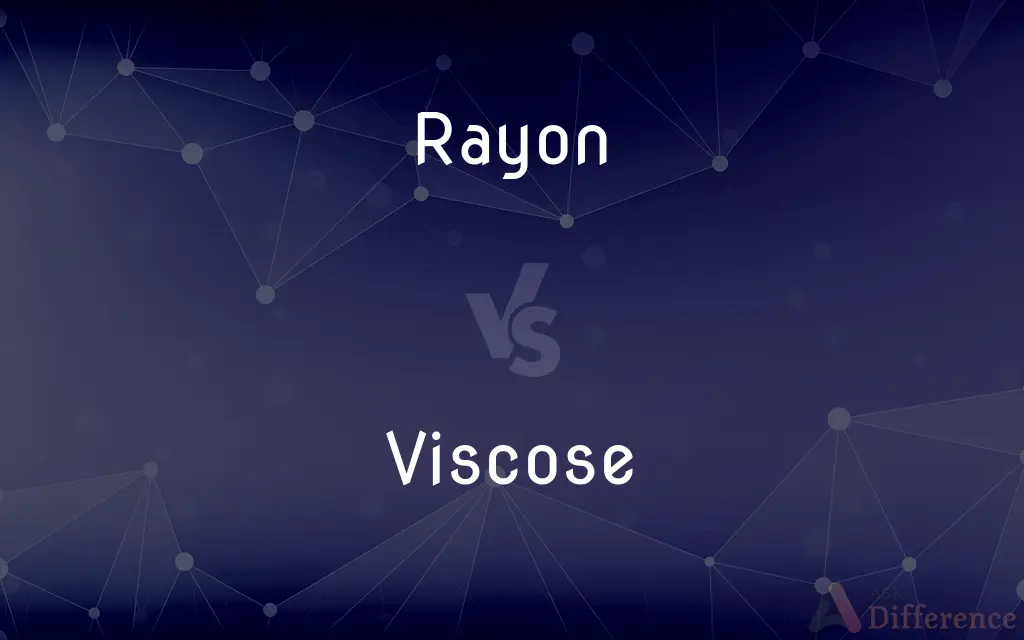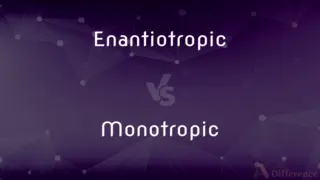Rayon vs. Viscose — What's the Difference?
By Fiza Rafique & Urooj Arif — Updated on April 18, 2024
Rayon and viscose refer to the same type of fabric, with "viscose" specifically denoting the method of how the rayon is produced using the viscose process.

Difference Between Rayon and Viscose
Table of Contents
ADVERTISEMENT
Key Differences
Rayon is a versatile fabric known for its silk-like feel, often used in clothing and home furnishings. Viscose, a type of rayon, specifically refers to the method involving the treatment of cellulose with sodium hydroxide and carbon disulfide.
While both terms are sometimes used interchangeably in the textile industry, "viscose" typically describes the production process of rayon, particularly when emphasizing the environmental impact and specific chemical use.
The viscose method results in a soft, highly absorbent fabric with a smooth texture, making it ideal for items that require a luxurious feel. Rayon, regardless of the specific production method, maintains similar qualities but can vary slightly in texture and performance based on the process.
In terms of environmental impact, the production of viscose rayon is often criticized for its use of hazardous chemicals, which can be harmful if not properly managed. This has led to increased demand for more sustainable practices within the rayon manufacturing processes.
Both rayon and viscose fabrics require careful handling and cleaning due to their delicate nature. They tend to be less durable than synthetic fibers like polyester, and they can lose strength when wet.
ADVERTISEMENT
Comparison Chart
Definition
A semi-synthetic fiber made from cellulose
A type of rayon made using the viscose process
Production Process
Can be made using the viscose process, modal process, or lyocell process
Involves treating cellulose with sodium hydroxide and carbon disulfide
Texture and Feel
Soft, smooth, and versatile
Specifically soft and smooth due to the viscose method
Environmental Impact
Varies; modal and lyocell are more eco-friendly than viscose
Often criticized for chemical-intensive production
Use in Textiles
Broad use in fashion and home textiles
Often preferred for luxurious garments and textiles
Compare with Definitions
Rayon
A semi-synthetic fiber derived from cellulose, commonly used for its silk-like feel.
The dress made of rayon draped beautifully due to its fluid nature.
Viscose
Subject to similar care requirements as other types of rayon, needing gentle handling.
Viscose clothing should ideally be hand-washed to avoid damage during cleaning.
Rayon
Popular in both fashion and home furnishings due to its aesthetic qualities.
Rayon curtains add a touch of elegance to interiors with their soft sheen.
Viscose
Used primarily in clothing that requires a soft drape and luxurious touch.
Viscose is often the fabric of choice for flowy skirts and blouses.
Rayon
Known for its versatility in textiles, it mimics the properties of natural fibers like cotton and silk.
Rayon is often used in blend with other fibers to enhance comfort and breathability.
Viscose
A type of rayon fabric produced by the viscose process, featuring a particularly smooth and shiny finish.
Viscose fabric is favored for its silk-like luster, making it popular for party dresses.
Rayon
Used in various production methods, including viscose, modal, and lyocell.
Rayon fabrics vary; some are more environmentally friendly than others depending on their production process.
Viscose
Involves an environmentally contentious production process using significant chemicals.
The production of viscose is under scrutiny for its impact on the environment and worker safety.
Rayon
Requires careful maintenance, prone to shrinking and wrinkling.
It is recommended to dry clean rayon garments to maintain their shape and finish.
Viscose
Highly absorbent and excellent for dyeing, offering vibrant colors.
Viscose holds dyes well, resulting in bright, saturated colors in textiles.
Rayon
Rayon is a synthetic fiber, made from natural sources of regenerated cellulose, such as wood and related agricultural products. It has the same molecular structure as cellulose.
Viscose
A thick, golden-brown viscous solution of cellulose xanthate, used in the manufacture of rayon and cellophane.
Rayon
Any of several synthetic textile fibers produced by forcing a cellulose solution through fine spinnerets and solidifying the resulting filaments.
Viscose
Viscose rayon.
Rayon
A fabric so woven or knit.
Viscose
Viscous.
Rayon
A manufactured regenerated cellulosic fiber.
Viscose
Of, relating to, or made from viscose.
Rayon
Ray; beam.
Viscose
A viscous orange-brown liquid obtained by chemical treatment of cellulose and used as the basis of manufacturing rayon and cellulose film.
Rayon
A synthetic fiber, made of thin filaments of regenerated cellulose, extruded from a solution of viscose. Called also viscose fiber and viscose rayon fiber.
Viscose
A fabric made from this material.
Rayon
A textile fabric made from rayon{1}.
Viscose
A cellulose ester obtained by treating cellulose with caustic soda
Rayon
A synthetic silklike fabric
Viscose
A rayon fabric made from viscose (cellulose xanthate) fibers
Common Curiosities
How does viscose differ from other types of rayon?
Viscose refers specifically to the production process involving hazardous chemicals, while other types like modal and lyocell use different, often more sustainable methods.
Are rayon and viscose environmentally friendly?
The environmental impact varies; viscose is less eco-friendly due to chemical use, while modal and lyocell are considered more sustainable options.
What is rayon?
Rayon is a semi-synthetic fiber made from regenerated cellulose, used widely in textiles due to its silk-like feel.
Why is viscose preferred for luxurious garments?
Its high absorbency and smooth texture make it ideal for garments requiring a luxurious feel and vibrant colors.
How is viscose produced?
Viscose is produced by treating cellulose with chemicals like sodium hydroxide and carbon disulfide, then spinning it into fibers.
What is viscose?
Viscose is a specific type of rayon produced through a process that involves dissolving cellulose and regenerating it into fibers.
Is viscose better than cotton?
While viscose offers a silkier feel and better dye absorption, cotton is more durable and environmentally sustainable.
Can rayon and viscose be used interchangeably in products?
Yes, viscose is a type of rayon, so products labeled as made from viscose are essentially using a specific type of rayon fiber.
What are the main uses of rayon in textiles?
Rayon is used in a variety of garments and home textiles, valued for its versatility and aesthetic qualities.
What are the care instructions for rayon and viscose?
Both require gentle care, preferably hand washing or dry cleaning, and should be handled delicately when wet.
Share Your Discovery

Previous Comparison
Dock vs. Doc
Next Comparison
Enantiotropic vs. MonotropicAuthor Spotlight
Written by
Fiza RafiqueFiza Rafique is a skilled content writer at AskDifference.com, where she meticulously refines and enhances written pieces. Drawing from her vast editorial expertise, Fiza ensures clarity, accuracy, and precision in every article. Passionate about language, she continually seeks to elevate the quality of content for readers worldwide.
Co-written by
Urooj ArifUrooj is a skilled content writer at Ask Difference, known for her exceptional ability to simplify complex topics into engaging and informative content. With a passion for research and a flair for clear, concise writing, she consistently delivers articles that resonate with our diverse audience.














































